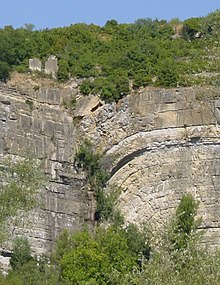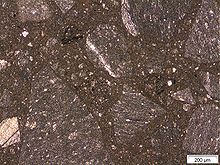Failure
In the field of geology, a fault is a fracture, generally flat, in the ground along which the two blocks have slipped relative to each other.
Faults are produced by tectonic stresses, including gravity and horizontal thrusts, acting on the crust. The rupture zone has a broadly well-defined surface called the fault plane, although it can be called a fault band when the fracture and associated deformation have a certain width.
When faults reach a depth in which the brittle deformation domain is exceeded, they become shear bands, their equivalent in the ductile domain. Faulting (or faulting) is one of the important geological processes during mountain building. Likewise, the edges of tectonic plates are formed by faults up to thousands of kilometers in length.
Elements of a failure
- Failure plan: Plano or surface along which the blocks that separate in the fault are moved. This plane may have any orientation (vertical, horizontal, or tilted). The orientation is described according to the course (angle between the North and the intersection line of the fault plane with a horizontal plane) and the dip or handle (angle between the horizontal plane and the intersection line of the fault plane with the vertical plane perpendicular to the course of the fault). Generally, fault plans are usually curved. The plane of failure can be polished by friction, giving rise to the so-called “fault specimens”. It is called 'fault band' when the deformation zone has a certain width. Instead of fault band is also used fault zone (English translation) fault zone) which produces confusion because fault area(s) is also used as synonym for fault system.
- Blocks or lips of failure: It is the two portions of rock separated by the plane of fault. When the plane of failure is tilted, the block that is above the plane of failure is called 'bond block' or 'lefted' and to which it is below, 'already block' or 'out'.
- Balance or displacement: It is the net distance and direction in which one block has moved over the other.
- Failure marks: These are rectilinear irregularities that may appear on some fault plans. They indicate the motion direction of the fault.
- Fault hook: in some cases a drag fold occurs in one or two lips of the fault, whose orientation will be different depending on the fault is normal or reverse and will indicate the sense of relative displacement.
Geometric classification of failures
From the point of view of the relative displacement of the blocks involved, the faults are classified as:
- Normal failure, direct or of gravity: when the pendant or ceiling block moves down from the existing block or wall block. The fault plane is tilted.
- Reverse failure, when the hanging block moves up in respect of the already-conscious. They are called riding to the reverse flaws of low angle of digging. The fault plane is tilted.
- Failure to address, address, transcurrent or tear: when the displacement is horizontal and parallel to the course of the fault. They can be, according to the sense of movement of the blocks (referred to the position of an observer on one of the blocks), sinistral or directional leftwhen the opposite block that the observer occupies moves to the left, and dextral or right directionalWhen the block moves to the right. The fault plane can be tilted or vertical. A particular type of failures in direction are the transformative flaws, which move segments of constructive edges of plates and the fault plane is usually vertical.
- oblique or mixed failure: when the displacement is oblique both to the direction and to the buzamiento direction. They are described simply as a combination of the terminology of the previous ones, resulting in four possible cases: reverse synistral, normal sinistral, reverse dextral and normal dextral.
- Rotational failure: when there has been a rotation component in relative displacement between the two blocks separated by the fault. In turn they can be divided into:
- Scissors failureWhen the rotation axis is perpendicular to the fault plane.
- Cylindrical failureWhen the rotation axis is parallel to the fault plane. The fault plane is usually curved.
- Conical failureWhen the rotation axis is oblique to the fault plane. The fault plane is usually curved.
Oblique Slide
- oblique or mixed failure: when the displacement is oblique both to the direction and to the buzamiento direction. They are described simply as a combination of the terminology of the previous ones, resulting in four possible cases: reverse synistral, normal sinistral, reverse dextral and normal dextral.
Fault associations and tectonic structures
The structures associated with the faults depend on the type of regional tectonic regime in which they have formed. However, there are some forms and terms common to all of them: it is common for faults to vary in dip along their path, showing relatively horizontal zones, landings, alternating with more inclined zones, ramps b>. The blocks bounded between fault ramps are called tectonic flakes or horses and the stacking of these flakes is called duplex.
In regions of tectonic extension
In a limited extension regime and in brittle deformation conditions, staggered normal fault systems develop, more or less parallel, which form sunken zones, called Grabens or tectonic trenches, which can alternate with elevated areas, called Horst or tectonic pillars.
If the extension is wide, the faults tend to horizontalize in depth (listric faults). In the development of the extension, fault systems can be formed with ramps and landings that follow one another and replace each other, delimiting scales that can be grouped into extensional duplexes.
At the crustal scale, the extensional faults that develop on the surface with a brittle behavior, pass into the ductile domain at depth, producing mylonitic bands in the detachment zone. In cases where stretching is significant, thinning of the crust can occur—a process called tectonic denudation—and isostatic readjustment can lift deep rocks to the surface.
In regions of tectonic compression
The most common forms associated with compression are produced by reverse faults: thrusts and thrust mantles, typical of the outer zones of collisional orogens, in what which is called the "thrust belt" and corresponds to the thin-skinned tectonic style.
In some regions affected by compression, with thrusts with detachments at the base of the upper crust or deeper (thick-skinned tectonic style), pop-up type elevations can be produced > and pop-down depressions (depressions between two thrusts of opposite vergence), both limited by reverse faults —in what differs from horst and grabens, limited by normal faults. This model of pops-up and pops-down is applied, for example, to the Spanish Central System.
At the crustal scale there can be overlapping and stacking of fragments of continental crust, as in the case of the Himalayas, in which extensive crustal blocks, delimited by large faults, ride one on top of the other.
In zones of transcurrent tectonics
In large tear-slip faults, whose displacement component is mainly horizontal, local compression or extension areas can be delimited that produce uplift or subsidence movements. The relay or bridge between two nearby faults or the local curvature of a fault in direction produces a zone in which the local direction of fracture is oblique or perpendicular to the direction of main displacement, forming flakes and duplexes associates.
Depending on the relief or rotation of the faults, to the right or left, and depending on the horizontal displacement of the faults, dextral or sinestral, the link zone between the two will have a compressive or distensive behavior of the scales and duplexes that would have formed, developing fan-shaped elevations, push-up type, or tectonic depressions of the pull-apart.
Gravitational Faults
They are produced exclusively by the effect of gravity, not by the action of tectonic forces. They can occur in different geological contexts:
- In the mid-oceanic dorsals, where they delimit the medium-oceanic rift.
- In karst soils, the dissolution of the substrate or the collapse of cavities.
- In volcanic regions, by collapse of magmatic chambers or slide of unstable volcanic buildings.
- In slopes or steep slopes.
Fault Rocks
In many cases, friction on the fault plane causes the crushing or deformation of the rocks that make it up. The deformation band can reach several tens of meters in thickness. Depending on the formation conditions, they can be of different types, among which there is a continuous gradation:
- In fragile deformation conditions the fault gapswhen the fragments (classes) are seen in plain view, or Fault floursWhen the nails are microscopic.
- In deeper conditions with higher temperature, they form Catalanwhich are rocks with greater cement than the previous ones. If the friction of the fault increases the temperature, to the melting point of some of the finer components of the rock, they can occur pseudotaquilitasDark rocks of vivid texture.
- When deformation occurs in the ductile or fragile-ductile domain, in conditions of metamorphism, the Thousand and Ultramilonite, which define the cizalla bands, with a characteristic banding of the rock.
Morphological features of fault lines on the earth's surface

The following features are often useful for identifying faults in the field:
- Failure scam: is the morphological trait produced on the Earth's surface due to the displacement of a fault. They constitute rectilinear morphologies through which the topography varies abruptly. Three main types can be distinguished:
- Primitive or original failure scheme: when the rust is recent or has not yet been dismantled by erosion.
- Fail or derivative line decay: when the involved blocks have been eroded and the original failure leap is not preserved or the differential erosion relief has even been reversed.
- Composite Failure Spray when the fault has been reactivated and the blocks involved have suffered differential erosion.
- triangular faces or rags: are forms associated with fault line scarpes or composite escarps due to erosion, by the intersection of cacadas or valleys perpendicular to the rectilinear plane of a fault escarpe and oriented towards the sunk block.
Active and inactive faults
A fault is considered active when it has moved one or more times in the last 10,000 years. Active faults are recognized by associated earthquakes, and in some cases become evident when manifesting with surface ruptures. Active faults can be seismic or seismic. In the first case, displacement along segments of the fault plane occurs sporadically, due to the application of tectonic forces in the vicinity of the fault, which produces elastic deformation of the rocks in that environment. When the shear strength of the rocks is exceeded by the magnitude of the stresses, rupture and displacement along the fault occur. The sudden displacement gives rise to an earthquake. After an earthquake there are periods of less or no activity, in which the rocks begin to accumulate stress again.
Earthquake faults, on the other hand, occur when stresses are permanently released by processes such as creeping (creep), or by successive small ruptures that cause very low-magnitude earthquakes and little spaced in time.
When fault movement is analyzed over geologic time (thousands to millions of years), regardless of whether the faults are seismic or aseismic, both types move at average speeds of a few millimeters to a few centimeters per year.
An example is the San Andreas fault system in southern and central California in the USA, which generated the San Francisco earthquakes (M=7.8, on the Richter scale) in 1906, Los Angeles (M=6.7) in 1994 and recently Hector Mine (M=7.1) in 1999 and San Luis Obispo (M=6.6) in 2003. The faults of the central part of the San Andrés system, on the other hand, they slide aseismically.
The inactive faults are those originated in the geological past, and that have not manifested recent activity. They do not represent any seismic hazard for nearby towns.
Notable flaws
- Failure of Altyn Tagh
- San Andrés Falla
- Falla de San Ramón
- North Failure of Anatolia
- Falla de Motagua
- Fagnano-Magallanes Falla
- Judge Albertino
Contenido relacionado
Chernozem
Khulna
Carbonate













